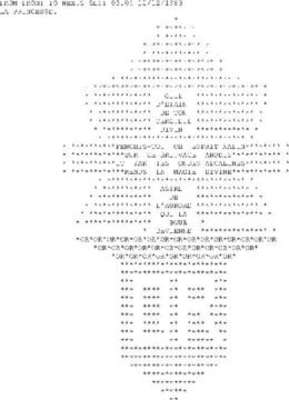| 1960 |
Univision Gallery, Newcastle upon Tyne |
| 1961 |
St.Johns Gallery, York |
| 1961 |
Artists International Association Gallery, London |
| 1963 |
Molton Gallery, London |
| 1964 |
Gallerie Suzanne de Conninck, Paris |
| 1965 |
Queen’s University, Belfast |
| 1965 |
Hamilton Galleries (Annely Juda), London |
| 1968 |
Laing Art Gallery & Museum, Newcastle upon Tyne |
| 1968 |
Ikon Gallery, Birmingham |
| 1969 |
Exe Gallery, Exeter |
| 1970 |
Angela Flowers Gallery, London |
| 1972 |
University of Guelph, Ontario |
| 1978 |
Anna Gardner Gallery, Stinson Beach, California |
| 1980 |
Dartington Hall, Totnes |
| 1980 |
Terminal Art, First International Artists’ Computer Conferencing project, USA – UK, Bristol (directed by Roy Ascott) |
| 1982 |
Four Wings (Planetary I Ching), International Telematic project, Ars Electronica Festival, Linz (Austria) |
| 1983 |
La Plissure du Texte (A Planetary Fairy Tale). Telematic project between artists in Paris, Amsterdam, Vienna, Bristol, Sydney, Vancouver, Pittsburgh, Toronto, San Francisco, Honolulu, Alma; Musée d’Art Moderne, Paris (directed by Roy Ascott) |
| 1985 |
Organe et Fonction d’Alice au Pays des Merveilles. Interactive videotex project (Minitel); Les Immateriaux at Centre Pompidou, Paris (directed by Roy Ascott) |
| 1985 |
Sonart: l’image à distance par son. Slowscan TV by short wave radio transmission, Alma – Québec, Pittsburgh. Alma, Québec: ANNPAC/RAC (directed by Roy Ascott and Robert Adrian) |
| 1986 |
Planetary Network: Laboratory UBIQUA. Artists in three continents interacting through computer networks, videotex, slowscan TV, fax. Venice: XLII Esposizione d’Arte La Biennale di Venezia (directed by Roy Ascott, Don Foresta and Tom Sherman) |
| 1987 |
Digital Body Exchange. Digital image network between artists in Gwent, Perth, Sidney, Vienna, and Pittsburgh. Vienna: Hochschule für Angewandte Kunst (directed by Roy Ascott) |
| 1988 |
Making the Invisible Visible. Telematic image/text exchange between artists at University of Applied Arts, Vienna, Carnegie-Mellon University and University College London. Vienna: Hochschule für angewandte Kunst (directed by Roy Ascott) |
| 1989 |
Aspects of Gaia: digital pathways across the whole earth. Interactive art installation and telematic project with artists in three continents. Linz: Ars Electronica Festival of Art and Technology (directed by Roy Ascott) |
| 1991 |
Texts, Bombs and Videotape. (Slowscan TV, digital image and fax exchange between artists in Vancouver, Pittsburgh, Vienna, and Bristol. Bristol: Watershed Media Centre (directed by Roy Ascott) |
| 1991 |
Virtuelle Werelden. Documentary exhibition of computer communication projects by Roy Ascott (also works by Peter Beyls and Hugo Heyrman), Antwerp: Internationaal Cultureel Centrum |
| 1992 |
The Geometry of Silence. Distributed sound installation. Vienna and Innsbruck: Museum Moderner Kunst and Ferdinandeum (directed by Roy Ascott) |
| 1992 |
Telenoia: a global networking project for the eighth day of the week. Telematic project using vidphone, fax, BBS, EARN. s-Hertogenbosch: V2 Organization (directed by Roy Ascott) |
| 1993 |
Three works made by Roy Ascott in the 1960s were included in the exhibition The Sixties Art Scene in Britain at the Barbican Art Gallery, London |
| 1994 |
Gasflow. Telematic project, Internet and walkie-talkies in a text/sound interchange. Amsterdam: Mission Impossible, Gashouder (directed by Roy Ascott) |
| 1995 |
Roy Ascott’s telematic art projects from 1984-94. Video documentation. Milan: Triennale di Milano |
| 1996 |
Identity in Cyberspace: WorldWideWeb and CD ROM project between artists in Newport, Barcelona and Dublin. Newport: CAiiA (directed by Roy Ascott) |
| 1996 |
Apollo 13. Interactive elevator (Televator), permanent installation. Concept design by Roy Ascott. Linz: Ars Electronica Center. |
| 1999 |
Art-ID/Cyb-ID. Identities in Cyberspace. WWW project. Biennal do Mercosul. Porto Alegre, Brazil |
| 2003 |
New Technologies. Ascott, Bolognini, Forest, Kriesche, Mitropoulos. Museo del Sannio Benevento, Italy |



